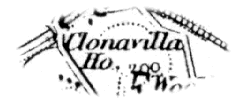of Clonavilla
c. 1800
 Click
here for: map of Clonavilla environs
Click
here for: map of Clonavilla environsand Elizabeth Young
c. 1804
1817
1832
See histories: 1830's
| James
Fitzgerald
of Clonavilla c. 1800 |
The grave marker of |
| The earliest church records studied thus far shows a John Fitzgerald of "Clinavilla" who died in 1818 at age 84 -- possibly James's uncle. (29) | |
| Clonavilla is a fair-sized property, nestled in the shallow valley of a tributary of the River Finn. From a nearby rise you can see on the next hill the central town of Clones. It's highest point is St. Tighernach's Church (pronounced 'tier-nock'), behind which is the burying ground of the local Church of Ireland parishioners including our Fitzgeralds. There are four graves there that date from the early to mid-1800's named for Fitzgeralds, although, aside from James's families' stone, the relation of the others is not yet known. | |
 Click
here for: map of Clonavilla environs Click
here for: map of Clonavilla environs |
|
| James Fitzgerald
and Elizabeth Young c. 1804 |
Around 1804, James married his second wife, Elizabeth Young. Remaining in Clonavilla, they had six children from 1804 to 1812, including our ancestor Anne Fitzgerald, born in April of 1806. |
| Elizabeth
dies
1817 |
Elizabeth died in 1817, and James's first son John died in 1818. |
| Anne meets
Michael Elliott
1832 |
In 1832, James's daughter Anne met Michael Elliott during his surveys
for the tithe applotment of Clones Parish. Curiously, although Michael
did refer to her father James's property, there was no tithe assessed on
Clonavilla. This may be an example of the unfair assessment practices which
led to a Tithe War in Ireland from 1830-1833. Poorer farmers were often
levied tithes because their land was productive, whereas the estates of
many well-off landowners technically produced nothing, and were therefore
tithe free.
See histories: 1830's |